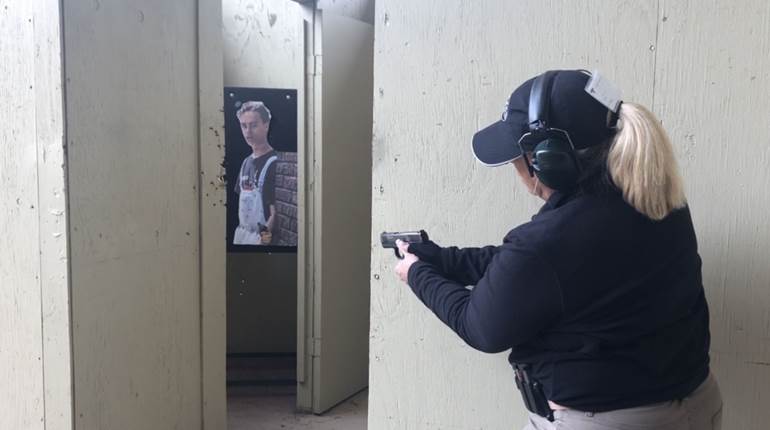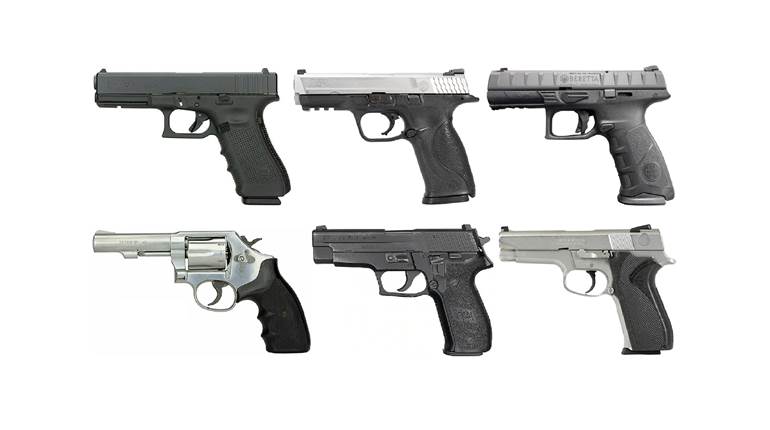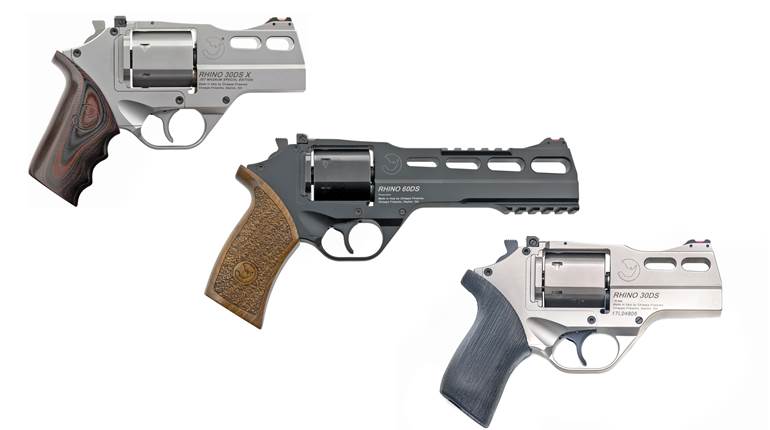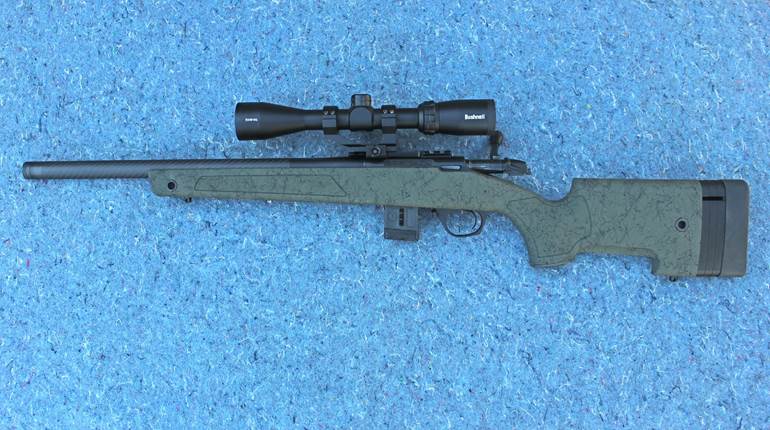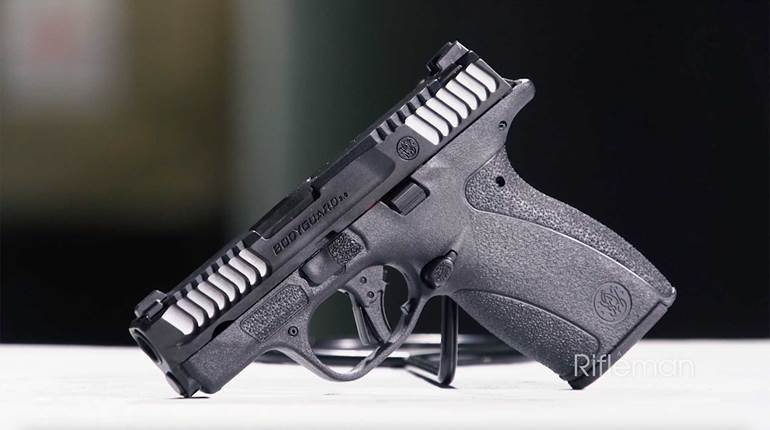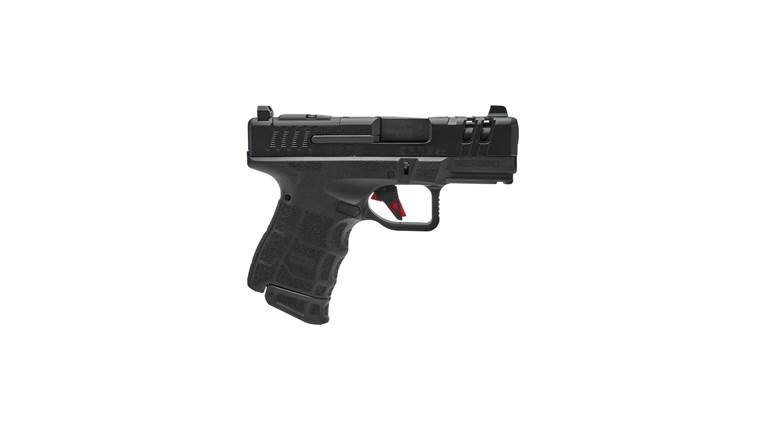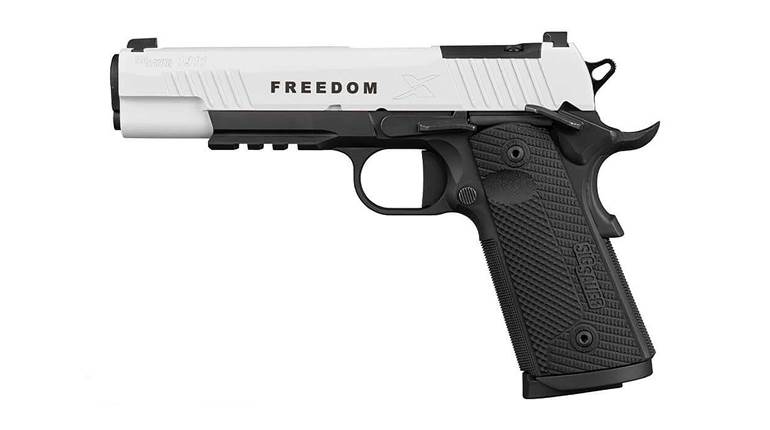
Blackpowder firearms have long been a part of my family's shooting tradition. Over the years, my father has put together a neat little collection with some beautiful examples of small, derringer-type pistols outfitted for percussion caps. My brother hunts with an in-line muzzleloader and my cousin spends his weekends at mountain-man rendezvous. Despite this lifelong exposure to powder horns and ram rods, I have yet to come across anything quite like the guns tested for this review: the North American Arms' (NAA) Companion series of Mini revolvers.
The Companions are among the smallest, if not the smallest, fully functional, .22-cal. cap-and-ball revolvers in production. These 5-shot single-action revolvers are constructed of 17-4 stainless steel with satin-finished flats and bead-blasted matte rounds. The smooth grip panels are made of laminated rosewood. The most diminutive member of the series, simply called The Companion, is built on the company’s .22-LR frame. Fitted with a 1.125" barrel, it has an unloaded weight of just 5.1 oz. The Super Companion, which is assembled on a .22-Mag. frame, sports a 1.625" barrel and weighs in at 7.1 oz.

The 4" barrel 1860 Companion takes its design cues directly from “The Earl” series. It's about as close to a replica of the 1858 Remington as a revolver this small can be. Unlike the other two Companions, which feature blade front sights and no rear sights, the 1860 Companion has a post in front and a notch at the rear. This revolver tips the scales at 9.2 oz.

Each Companion arrives with the accessories needed to operate them, along with a complete set of removable cap nipples installed in the cylinder. Inside the case, you'll find a 50-round packet of proprietary belted .22-cal. 30-gr. round-nose lead bullets, a powder charge, a nipple wrench and a stick pin with a "T" shaped handle intended for use as a de-capping tool. There's no room on the Companions' frame for a functional, integral ball rammer. Instead, a handheld bullet seater is provided. The grip frames are fully compatible NAA’s diverse selection of grips.

For an additional $45, the Companion's accessory set can be beefed up with an addtional kit which includes a second cylinder, a replica Civil War-era flap holster, a leather bullet pouch and an additional 250 lead bullets. The #11 percussion caps, bullet grease, and propellant needed for these guns to go BANG will need to be purchased from a local sporting goods store.

It should be noted here that the Companions are built to tight tolerances and the nipples are recessed into the cylinder. As a result, not all brands of percussion caps will operate successfully with these guns. As I tested a variety of caps, I learned that some brands contain minor variations in the thickness of the primer compounds. Though these slight differences are rarely ever an issue with traditional blackpowder revolvers or muzzleloaders, a cap that sticks up a little bit too high from the nipple recess of a Companion will catch on the frame causing the revolver to jam. I mention all this here because if a Companion's action feels rough, or heavy, or impossible to cycle, there’s a 99.9% chance that the caps don't fit.

I had the best results with Remington's #11 percussion caps. They all seated to a uniform depth in the nipple recesses and allowed the cylinder to rotate freely. By the way, the occasional burst percussion cap will also jam the gun. Rather than trying to cycle past a flared-out or loose cap, it’s easier to remove the cylinder, brush away the problem cap, and then finish firing the remaining loaded chambers.

Hodgdon offers some of the best propellants available for blackpowder shooting. Though the Companion revolvers can shoot real blackpowder, I prefer to work with the more stable substitutes. The Pyrodex P (the P stands for Pistol) is an old standby that burns reliably, produces dependable results, and is not too difficult to clean up.

When I joined my brother on a trip to the range to sight in for deer season, he introduced me to Hodgdon's Triple Seven products. He likes the results the pellet version yields in his in-line muzzleloader. I contacted Hodgdon and asked if the powder version of Triple Seven would be a viable option for the Companions. They said it would be, and it ran nicely. In fact, I shot one of the Companion revolvers exclusively with the Triple Seven to test their claim of water-only cleanup. The sulfur-free powder residue rinsed right out of the bore and off of my hands. I'm not ready to give up the Pyrodex P just yet, but I am looking forward to working with the Triple Seven in the future.

Preparing a factory fresh Companion for its first live-fire session requires the following steps. Begin by setting the hammer in a half-cocked position. Remove the cylinder pin and then the cylinder from the frame. Check the tightness of each nipple using the provided Allen wrench. It’s important to have them snuggly set, but not too tight, since they will need to be removed for cleaning at the end of the shooting session. Press a percussion cap onto the nipple of each unloaded chamber without loading any powder or bullets. Reinstall the cylinder and fire all five caps downrange. This cap-only round blows out any excess oil, moisture, or dirt from the nipples.
Loading the diminutive Companions is a more manually involved process than with some guns, including fullsize Cap & Ball revolvers which are loaded while fully assembled. I won't say it's a slow process since, with practice, any loading routine becomes faster and more efficient. But I will say that I was glad to be able to sit down while I worked.

A small plastic container will come in handy when loading your powder. It provides a clean surface for the cylinder to rest on and it will catch any grains of powder that try to escape. A fellow shooting enthusiast at the range thought a funnel would be required to get the small charge of powder into the .22-cal. chambers. But the powder measure did a good job all on its own when I didn’t rush the process. I found the best approach to getting the powder where I wanted it was to cover four of the five cylinders’ chamber mouths with the tips of the index and middle fingers of my left hand while I poured the powder using my right. This prevented any powder from spilling into the other chambers and created a “V” shaped channel to catch any loose grains until they could be chased into place.

A correctly measured powder charge fills each chamber up to the interior ridge that circles the chamber wall. This ridge works to keep the bullets from being seated too deeply. No patch or wad is required. Just pour in the powder and then seat the bullets using the handheld tool. Do not install the caps before the powder and bullets are in place because the bullet-seating process can ignite the caps.

With all five bullets seated, I used the tip of my little finger to lay a coat of grease across the top of the cylinder. The grease works to lubricate the bullets and to prevent chain firing. Out of curiosity, I tried different greases, including store-bought bullet lubricants and vegetable shortening. All of them did the trick, so it’s just a matter of preference. Shortening is cheap and readily available, while the bullet lubricants are formulated so as to not become runny in hot weather.

Once all of these steps were completed, the percussion caps were pressed into place. The cylinder is now ready to be installed in the frame and fired. Remember that the Companions' cylinders do not have the hammer safety slots of the rimfire versions. If a Companion is going to be carried loaded, then the hammer must be set on an empty chamber with no cap in place.

Another notable difference between the Companions and the rimfire Mini models is the configuration of the firing pin. The rimfire models have a hatchet-shaped firing pin mounted to the hammer while the Companions have a spring-loaded, frame-mounted firing pin. When firing the Companions, a drop or two of lubricant placed on the firing pin about every fifteen shots keeps the pin from seizing up with powder fowling. A variety of gun oils or CLPs will do the trick, but I've found the lubricant “pens” and bottles with needle applicators are particularly handy for this task.

While I knew the Companions would be interesting to shoot as a group, I was pleasantly surprised to find that each one had its own personality. The .22 LR framed Companion is clearly an exercise in blackpowder miniaturization. How small can a cap-and-ball revolver be, function reliably, and still be enjoyable to shoot? The Companion answers these questions nicely. Though it is tiny in every respect, it has just enough of a grip to grasp and a powder charge just large enough to make it fun to work with. It quickly caught the attention of other shooters on the range. Folks were interested in all three revolvers but they usually wanted to hold the Companion.

The .22 Mag. framed Super Companion, with nearly double the powder charge of the Companion, spoke with more authority than its little sibling. The longer barrel and larger grip frame makes it easier to keep shots on target. The Super Companion offers a balance of greater shootability while maintaining an exceptionally compact size. This is the model that would be ideal to keep in your kit for some pleasant informal shooting while out on the trail.

If you want to squeeze as much performance as possible out of this platform, then the 1860 Companion is the way to go. The 4" barrel placed bullets to point-of-aim all the way out to 15 yards. That’s a solid level of accuracy for some sub-compact cartridge pistols, let alone a miniature cap-and-ball like this one. I rarely had a wandering shot when I did my part. The square base of the extended boot grip rested nicely on the little finger knuckle of my shooting hand, which aided in aiming and stability. This is the model that most closely replicates the experience of shooting a traditional blackpowder revolver, but at about 1/3 of the scale.

Whether you are a fan of blackpowder shooting or a follower of North American Arms’ Mini revolvers, the Companion series has something for you. Like many other blackpowder/muzzleloading firearms, the Companions qualify as “Antiques” under federal law and therefore do not require an FFL transfer like the rimfire Minis. Be sure to read your owner’s manual and to have a clear understanding of all the supplies you need before you head to the range.

Specifications:
Manufacturer: North American Arms
Model: Companion Cap & Ball (NAA-22LR-CB)
Action: Single-Action Revolver
Caliber: .22, Proprietary 30-gr. Lead Bullets
Percussion Cap: #11
Finish: Satin Stainless Steel
Grip Frame: Birdshead
Grip Panels: Laminated Rosewood
Front Sight: Fixed Half-Moon
Rear Sight: None
Barrel Length: 1.125"
Overall Length: 4"
Cylinder Width: 0.76"
Weight: 5.1 oz.
Capacity: 5 Rounds
Accessories: Storage Case, 50-round Bullet Packet, Manual Bullet Seating Tool, Powder Charge, Nipple Wrench, De-capping Pin, Owner's Manual
MSRP: $251
Model: Super Companion Cap & Ball (NAA-22M-CB)
Action: Single-Action Revolver
Caliber: .22, Proprietary 30-gr. Lead Bullets
Percussion Cap: #11
Finish: Satin Stainless Steel
Grip Frame: Birdshead
Grip Panels: Laminated Rosewood
Front Sight: Fixed Half-Moon
Rear Sight: None
Barrel Length: 1.625"
Overall Length: 5.15"
Cylinder Width: 0.76"
Weight: 7.1 oz.
Capacity: 5 Rounds
Accessories: Storage Case, 50-round Bullet Packet, Manual Bullet Seating Tool, Powder Charge, Nipple Wrench, De-capping Pin, Owner's Manual
MSRP: $261
Model: 1860 Companion Cap & Ball (NAA-1860-4-CB)
Action: Single-Action Revolver
Caliber: .22, Proprietary 30-gr. Lead Bullets
Percussion Cap: #11
Finish: Satin Stainless Steel
Grip Frame: Birdshead
Grip Panels: Laminated Rosewood Boot Grips
Barrel: Hexagonal
Front Sight: Post
Rear Sight: Fixed Notch
Barrel Length: 4.00"
Overall Length: 8.00"
Cylinder Width: 0.76"
Weight: 9.2 oz.
Capacity: 5 Rounds
Accessories: Storage Case, 50-round Bullet Packet, Manual Bullet Seating Tool, Powder Charge, Nipple Wrench, De-capping Pin, Owner's Manual
MSRP: $316












